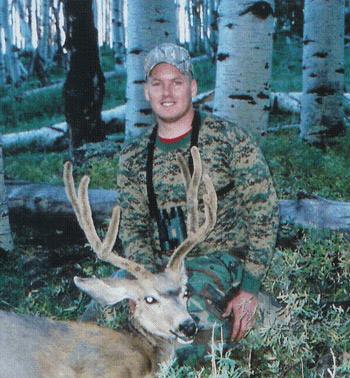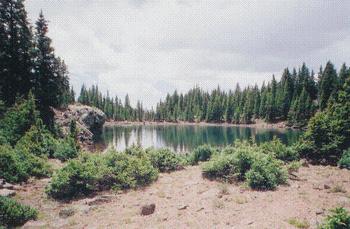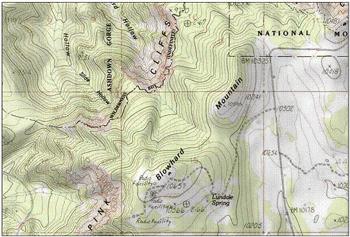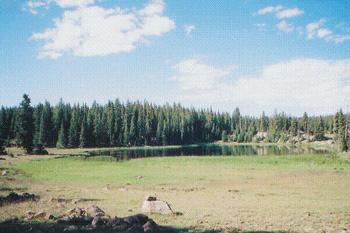5 Secrets To Bowhunting Success
By Mike Twitchell
Archery has been a unique part of my life from a very young age. My first archery hunt was when I was fifteen years old. With no prior hunting experience other than killing a lot of dots on paper, I set out ill prepared and full of anticipation. To this day the largest buck I have ever seen was the one I missed with my bow on that first archery hunt! Needless to say, a lot has changed since then and many personal vows to "never do that again" have been made. Does any of this sound familiar to anyone? I'll bet it does. It is with these necessary experiences however, that we make the needed changes to become successful.

There is a list longer than I care to mention here of what I learned from that first hunt - patience, patience, patience probably being the most important. There are a few others that may be beneficial to share however. Some of which have been reaffirmed to me through the years by watching others make the same mistakes that I had made.
Lesson Number One: Equipment.
Yes, that's right. Equipment! This poor dead horse is going to get another beating. But, for good reason! It seems every year in early August when I slip over to visit a good friend at the local pro shop I see the same scene. Joe Hunter walks through the door with a bow covered in an inch of dust. The bow looks like it was made in about 1985(Ancient for Archery Equipment) and something that my dad's dad would have hunted with. Joe says that he drew an archery tag and wants to go hunting. The same thought runs through my buddies mind and mine simultaneously. "When was the last time you picked this thing up?"

Now don't get me wrong. This is an extreme example but it happens more than you would care to see. Just ask your pro shop. Many of us make our livelihood with our hands. More importantly many of us make our livelihoods with our tools. We all know that a great craftsman is only as good as the tools he uses. I suggest to you that hunting is no different. A great hunter, whether he is an archery hunter or a long range rifle hunter, is only as good as his equipment allows him to be. So let's do ourselves a big favor and not allow our equipment to be a determining factor for our success, especially when many years and dollars are spent accumulating bonus points for the big hunt. An archery hunter has a wide range of tools needed to be successful. Being in the archery community for many years, it has been amazing to see the progress of equipment development in the last five years alone. There has never been a better time to take up this sport with all that is available.
After you have selected your equipment make sure that you practice, practice, practice. I like to practice for every possible situation that I may be faced with in the field. Practice shots from your tree stand. Shoot with your pack on. Shoot from your blind. The more familiar that you get with your equipment the more adept you will become. Make sure to practice with your broadheads as they can fly drastically different than field points.
Most bows will need minor tuning adjustments to shoot broadheads, especially fixed blade broad heads. If you are having trouble getting your blades to fly, one trick is to shoot one broad head on several different arrows. Don't ask me why it works but it does. Expandable broad heads seem to tune more easily than fixed blade broadheads and can be a good alternative. Make sure to check your local laws for regulations concerning acceptable gear.
Lesson Number Two: Preseason Scouting
Luckily for archery hunters in most areas, they are the first ones in the woods. This is excellent for preseason scouting. There are many methods used to find big bucks and bulls. It has been my experience that a combination of several methods has yielded the best results. Here are some of the techniques that I have used.
Topographical maps are a great place to start, especially if you are hunting an area that you have not been in much before. I still use topographical maps for areas that I have hunted a lot. National Geographic TOPO is a program that I use. They make programs for each state and are the same maps that one would receive from USGS. The benefit of owning the program is that you can print unlimited maps.

Trail cameras are an effective way to catch animals accessing a water hole, salt lick or trailing from feeding areas to bedding areas. They offer data that is invaluable to an archery hunter. Knowing when and where game is moving and where they are going is CRITICAL! A trail camera allows you to observe things when you can't be there personally. It's like being in the woods 24/7. Plus it's like Christmas every time you view your memory card. There is nothing like finding that trophy on your trail camera.
Mineral licks are one way that you can bring deer to you. If you will be hunting from a tree stand, salt licks can help you to position deer moving through your area for a shot. I like to use Apple Buck Jam or Deer Co-Cain. Both are very effective if used as directed.
Glassing helps you to get up close and personal from long distances. Out here in the west there are many open areas that are vast in size. Being able to cover lots of ground from one position saves on both fuel and energy, but allows you to observe an area without disturbing it. Big mule deer are familiar with every inch of their habitat. Any changes are noted and can affect their day to day routine. Patterning them from a distance and then only entering their area to stalk them before the kill is very effective.
What you are looking for when scouting is two things. Firstly, you are looking for an animal worthy of your efforts. Secondly, you are patterning their behavior to find mistakes in their routines. This allows you to know what he is going to do before he does it.
Lesson Number Three: Wind.
In all hunting venues, the wind seems to affect us all. For long range hunters, wind affects trajectory and bullet impact. For archers wind affects the deer's defenses. Anyone who has hunted knows that a deer's sense of smell is very keen.

Therefore we must use the wind to our advantage at every moment. In the Western Rockies it is especially important because the wind often circles. Yes it circles. I have seen many times when you ascend a hill the wind will be blowing one direction and within a few paces it will have completely shifted. An archery hunters best friend is his "Squeeze Breeze." Several companies make this product. It is simply a little plastic bottle filled with a white powder. When the bottle is squeezed some white powder is blown into the air and carried in the wind current. This allows one to always be aware of wind direction. You can make your on by loading some cornstarch into a plastic bottle with a small flip top.
Lesson Number Four: Camouflage.
What you wear during your hunt is important to your success. However, realize that oftentimes products are made for hunters as much as game. I would recommend only a few things in this area. Consider the type of habitat that you will be hunting and shop for your camouflage accordingly. In the West the tones of your camouflage will be much lighter than they are in the Midwest and Eastern States. Here quaken aspens, sagebrush and evergreens dominate the landscape with patches of scrub oak mixed in.
I have had success wearing differing camouflage patterns and oftentimes mixing one with another (i.e. digital woodland upper with traditional woodland lower). Most importantly I stress the need to cover the skin with long sleeved shirts and head net or camouflage paint. Facial hair works great, too! For you older fellas that feel bad about some gray in your beard, be happy that you have some all natural face camo.
Camouflage can also be applied to your method of hunting. This could include either a ground blind or a tree stand. I love tree stands because they often help or eliminate the issues faced with wind. They also put you in a different space that game can be less aware of. Buy a quality, comfortable stand if this is your choice. Life can be hard if you're uncomfortable 20-30 feet up a tree.
Lesson Number Five: Close is Better than Far.
One of the most rewarding things in hunting is to harvest an animal with a bow, especially a trophy! Being close has its rewards. The opportunity to use an animal's senses against them and to fool their better judgment is a serious challenge. Archery hunters generally take their animals at under forty yards. At this distance you have the chance to observe the habits and actions of your quarry in their very home. When was the last time that you were close enough to read a big game animal's face? Well, now may be the time to give it a try.
Having spent several seasons in the field with my bow, I can say that it will be some of the most fun and rewarding time that you may have hunting. Remember, quality equipment will help you to have the confidence needed to be successful. Your local pro shop can help guide you in selecting the necessary tools needed for your next hunt. Don't be afraid to ask around and listen to what others may suggest. Archery hunters may just be the most dedicated and committed hunters you come across.
Scouting in advance will help save precious time during the hunt. Plus it is fun to watch your trophy through the summer as you strategize how to get him in the freezer. Make sure when you are in the field to be aware of your surroundings. Often times they can give you cues as to what to do next. The lay of the land will direct game in certain patterns that you can use to your advantage. Make sure to take constant note of the wind. Concealment is your greatest ally. A big buck will know of everything that is happening around them. Choose your gear carefully and you will have every advantage necessary to be successful. Good luck and good hunting.
Until next time,
Mike Twitchell
By Mike Twitchell
Archery has been a unique part of my life from a very young age. My first archery hunt was when I was fifteen years old. With no prior hunting experience other than killing a lot of dots on paper, I set out ill prepared and full of anticipation. To this day the largest buck I have ever seen was the one I missed with my bow on that first archery hunt! Needless to say, a lot has changed since then and many personal vows to "never do that again" have been made. Does any of this sound familiar to anyone? I'll bet it does. It is with these necessary experiences however, that we make the needed changes to become successful.

There is a list longer than I care to mention here of what I learned from that first hunt - patience, patience, patience probably being the most important. There are a few others that may be beneficial to share however. Some of which have been reaffirmed to me through the years by watching others make the same mistakes that I had made.
Lesson Number One: Equipment.
Yes, that's right. Equipment! This poor dead horse is going to get another beating. But, for good reason! It seems every year in early August when I slip over to visit a good friend at the local pro shop I see the same scene. Joe Hunter walks through the door with a bow covered in an inch of dust. The bow looks like it was made in about 1985(Ancient for Archery Equipment) and something that my dad's dad would have hunted with. Joe says that he drew an archery tag and wants to go hunting. The same thought runs through my buddies mind and mine simultaneously. "When was the last time you picked this thing up?"

Now don't get me wrong. This is an extreme example but it happens more than you would care to see. Just ask your pro shop. Many of us make our livelihood with our hands. More importantly many of us make our livelihoods with our tools. We all know that a great craftsman is only as good as the tools he uses. I suggest to you that hunting is no different. A great hunter, whether he is an archery hunter or a long range rifle hunter, is only as good as his equipment allows him to be. So let's do ourselves a big favor and not allow our equipment to be a determining factor for our success, especially when many years and dollars are spent accumulating bonus points for the big hunt. An archery hunter has a wide range of tools needed to be successful. Being in the archery community for many years, it has been amazing to see the progress of equipment development in the last five years alone. There has never been a better time to take up this sport with all that is available.
After you have selected your equipment make sure that you practice, practice, practice. I like to practice for every possible situation that I may be faced with in the field. Practice shots from your tree stand. Shoot with your pack on. Shoot from your blind. The more familiar that you get with your equipment the more adept you will become. Make sure to practice with your broadheads as they can fly drastically different than field points.
Most bows will need minor tuning adjustments to shoot broadheads, especially fixed blade broad heads. If you are having trouble getting your blades to fly, one trick is to shoot one broad head on several different arrows. Don't ask me why it works but it does. Expandable broad heads seem to tune more easily than fixed blade broadheads and can be a good alternative. Make sure to check your local laws for regulations concerning acceptable gear.
Lesson Number Two: Preseason Scouting
Luckily for archery hunters in most areas, they are the first ones in the woods. This is excellent for preseason scouting. There are many methods used to find big bucks and bulls. It has been my experience that a combination of several methods has yielded the best results. Here are some of the techniques that I have used.
Topographical maps are a great place to start, especially if you are hunting an area that you have not been in much before. I still use topographical maps for areas that I have hunted a lot. National Geographic TOPO is a program that I use. They make programs for each state and are the same maps that one would receive from USGS. The benefit of owning the program is that you can print unlimited maps.

Trail cameras are an effective way to catch animals accessing a water hole, salt lick or trailing from feeding areas to bedding areas. They offer data that is invaluable to an archery hunter. Knowing when and where game is moving and where they are going is CRITICAL! A trail camera allows you to observe things when you can't be there personally. It's like being in the woods 24/7. Plus it's like Christmas every time you view your memory card. There is nothing like finding that trophy on your trail camera.
Mineral licks are one way that you can bring deer to you. If you will be hunting from a tree stand, salt licks can help you to position deer moving through your area for a shot. I like to use Apple Buck Jam or Deer Co-Cain. Both are very effective if used as directed.
Glassing helps you to get up close and personal from long distances. Out here in the west there are many open areas that are vast in size. Being able to cover lots of ground from one position saves on both fuel and energy, but allows you to observe an area without disturbing it. Big mule deer are familiar with every inch of their habitat. Any changes are noted and can affect their day to day routine. Patterning them from a distance and then only entering their area to stalk them before the kill is very effective.
What you are looking for when scouting is two things. Firstly, you are looking for an animal worthy of your efforts. Secondly, you are patterning their behavior to find mistakes in their routines. This allows you to know what he is going to do before he does it.
Lesson Number Three: Wind.
In all hunting venues, the wind seems to affect us all. For long range hunters, wind affects trajectory and bullet impact. For archers wind affects the deer's defenses. Anyone who has hunted knows that a deer's sense of smell is very keen.

Therefore we must use the wind to our advantage at every moment. In the Western Rockies it is especially important because the wind often circles. Yes it circles. I have seen many times when you ascend a hill the wind will be blowing one direction and within a few paces it will have completely shifted. An archery hunters best friend is his "Squeeze Breeze." Several companies make this product. It is simply a little plastic bottle filled with a white powder. When the bottle is squeezed some white powder is blown into the air and carried in the wind current. This allows one to always be aware of wind direction. You can make your on by loading some cornstarch into a plastic bottle with a small flip top.
Lesson Number Four: Camouflage.
What you wear during your hunt is important to your success. However, realize that oftentimes products are made for hunters as much as game. I would recommend only a few things in this area. Consider the type of habitat that you will be hunting and shop for your camouflage accordingly. In the West the tones of your camouflage will be much lighter than they are in the Midwest and Eastern States. Here quaken aspens, sagebrush and evergreens dominate the landscape with patches of scrub oak mixed in.
I have had success wearing differing camouflage patterns and oftentimes mixing one with another (i.e. digital woodland upper with traditional woodland lower). Most importantly I stress the need to cover the skin with long sleeved shirts and head net or camouflage paint. Facial hair works great, too! For you older fellas that feel bad about some gray in your beard, be happy that you have some all natural face camo.
Camouflage can also be applied to your method of hunting. This could include either a ground blind or a tree stand. I love tree stands because they often help or eliminate the issues faced with wind. They also put you in a different space that game can be less aware of. Buy a quality, comfortable stand if this is your choice. Life can be hard if you're uncomfortable 20-30 feet up a tree.
Lesson Number Five: Close is Better than Far.
One of the most rewarding things in hunting is to harvest an animal with a bow, especially a trophy! Being close has its rewards. The opportunity to use an animal's senses against them and to fool their better judgment is a serious challenge. Archery hunters generally take their animals at under forty yards. At this distance you have the chance to observe the habits and actions of your quarry in their very home. When was the last time that you were close enough to read a big game animal's face? Well, now may be the time to give it a try.
Having spent several seasons in the field with my bow, I can say that it will be some of the most fun and rewarding time that you may have hunting. Remember, quality equipment will help you to have the confidence needed to be successful. Your local pro shop can help guide you in selecting the necessary tools needed for your next hunt. Don't be afraid to ask around and listen to what others may suggest. Archery hunters may just be the most dedicated and committed hunters you come across.
Scouting in advance will help save precious time during the hunt. Plus it is fun to watch your trophy through the summer as you strategize how to get him in the freezer. Make sure when you are in the field to be aware of your surroundings. Often times they can give you cues as to what to do next. The lay of the land will direct game in certain patterns that you can use to your advantage. Make sure to take constant note of the wind. Concealment is your greatest ally. A big buck will know of everything that is happening around them. Choose your gear carefully and you will have every advantage necessary to be successful. Good luck and good hunting.
Until next time,
Mike Twitchell

